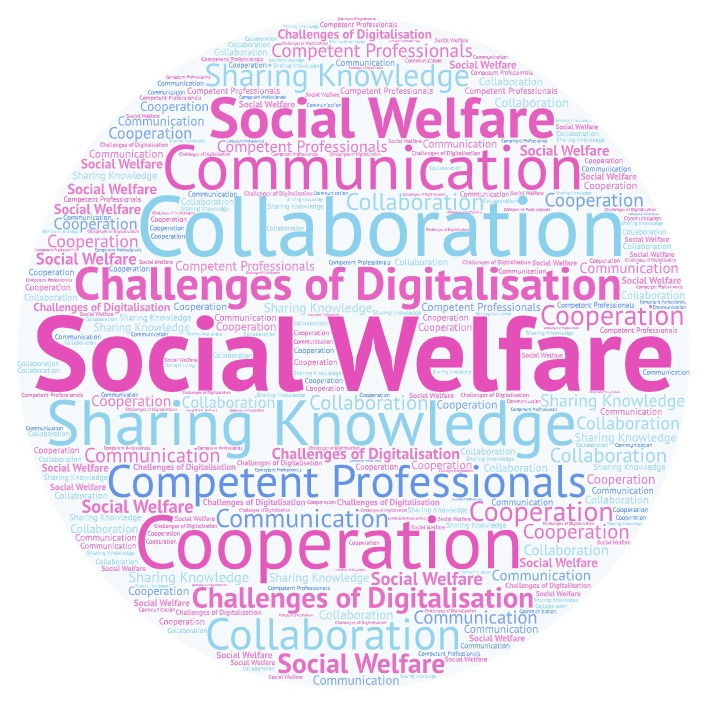
Savonia article: Challenges of Digitalisation in the Social Welfare
#SavoniaUAS
With the digitalisation transformation of the world, we are standing just at the beginning of the fourth industrial revolution, also called the new age or the digital age. There is happening a change of eras with constant disruption. This complex matter is the last few years an important subject in the social welfare as well.
This article seeks answers to the challenges posed by digitalisation.
How a Welfare Organisation keep track on the fast-changing developments in the digitalisation?
To gain knowledge about the newest developments in the digitalisation relevant to the social welfare, different knowledge resources, channels and tools should be used. Resources could be written literature, documents, conferences, and national institution’s own websites, but also peers and networks of people.

Knowledge can be accessed through different tools. Examples are ‘enterprise social media’ and collaboration tools, such as MS Teams. Networking and collaboration are important, because the organisation often do not know where to get the best information. Networks are sharing best practises and gaining new insights.
The importance of the establishment of communities regarding digitalisation within the organisation cannot be emphasised too much. It increases employee participation, ideas are shared, and engagement increases. Also, the expertise is flowing between different layers and trust increases. Field workers and customers have a lot of practise-based experience and could be co-creators in digitalisation. This all makes that organisation’s ‘tacit’ knowledge, the knowledge in the people’s heads, is captured.
Cooperation between departments of organisations must be enhanced because no one should be alone responsible for the digitalisation within the organisation. Digitalisation projects enhance the many aspects of digitalisation. A community of ‘Champions’ is existing out of people with knowledge about a specific aspect of digitalisation. They can support colleagues and influence their attitude towards digitalisation. Networks between different organisation are crucial in gaining new knowledge. Different partnerships can be set up.
Student teams are beneficial in developing new workforce skills. Organisations should evolve in fully collaborative organisations. Collaborative organisations take more risk as a group, but the risk of failure decreases. One’s failure should be acceptable.
Collaborative organisations are more organised, interdependent to one another and committed. Virtual teams make collaboration easier. Crowdsourcing and Hackatons are other ways to get new ideas from external people. To be successful as an organisation, digitalisation should be part of a clear strategy with a long-term vision.
How to make good decisions regarding digitalisation?
Through decision-making frameworks, it is possible to increase good decisions and it is the most likely that a good decision produces a good decision outcome. Spetzler et al 2016 has set up a six steps approach to come to decision quality in the decision-making process. These are the creation of a decision framework, the creation of alternatives, collecting relevant and reliable information, requirements based on values, sound reasoning practises and the commitment to action.
In the decision-making process, the external environment must be considered: how digitalisation is affecting the organisation, the latest trends, knowing what competitors are doing and the performance of different suppliers and vendors. Decisions must be based on the long-term goals and vision of the organisation.
The starting point of decision-making can be the customer’s needs or the already available solutions. People from different departments and professions should take part in the decision-making process. When the decisions about a solution affect the employee or customer, it is likely that they are involved too.
There are many aspects which must be integrated into the decision-making, such as supportive, technical and knowledge aspects and the aspects that are considering customers. Another approach is agile development, where the end-product is not defined yet, but through evaluation constantly improved. A decision can be made by providing ‘pitching’-events. Providers can present their product, but the decision is made by end-user’s testing and feedback.
How the organisation know that they have the right professionals in enhancing digitalisation depending on the taken steps
The tacit knowledge of the employees must be captured to find digital talents inside the organisation, depending on the different digitalisation subjects. Knowledge can be for example captured through interviews and surveys. A gap analysis can show the missing knowledge within the organisation and based on that adjusting their recruitment strategy.
It is challenging to determine who are the right professionals in enhancing the digitalisation of the organisation. There are methods in order to increase the number of competent professionals in the organisation as mentioned. The organisation should determine what competencies they need, depending on the different digital leaps and base their selection of professionals on that. Knowledge profiles can be set up for every employee.
How should the organisation communicate about digitalisation within the organisation?
Due to the constant change in the digital age, good communication regarding digitalisation is based on good change management.
Change causes uncertainty amongst employees. To keep them involved, they keep control over the situation. Good methods are employee participation and transparent communication. Communication about future goals and vision must be clear and inspiring. The benefits of digitalisation and the need for change must be explained to the employees and their customers.
Resistance to change is usually caused by lack of information, employee participation and trust. Resistance can appear because of the fear being overheard or overall prejudices around the usage of digital solutions. Those who has more positive experiences with digital solutions are more open to change.
Professionals should participate in testing and training of the solution to improve acceptance. A user training, education or support program should be provided for all the employees working with a new digital solution. In addition, leaders must have skills to support people at the bottom, instead of leading from the top.
Organisational beliefs and values should be shared by everyone in the organisation to gain trust. Furthermore, organisations should support employees in building personal resilience to cope with this constantly changing environment. The organisational culture must support innovation, collaboration, and teamwork.
Different platforms, such as Intranet and Learning Management Systems can be beneficial for communication. It is important to know in what degree the platform is used, what employees are missing and what can be improved.
Authors:
Petteri Strikwerda, student, Master’s Degree Programme in Digital Health, TYDI18SY. Bachelor in social work and social services, Petteri.Strikwerda@edu.savonia.fi.
Liisa Klemola, Lecturer, PhD. Savonia University of Applied Sciences, Unit of Continuous Learning, Master School, Kuopio.
References are available from the first author.